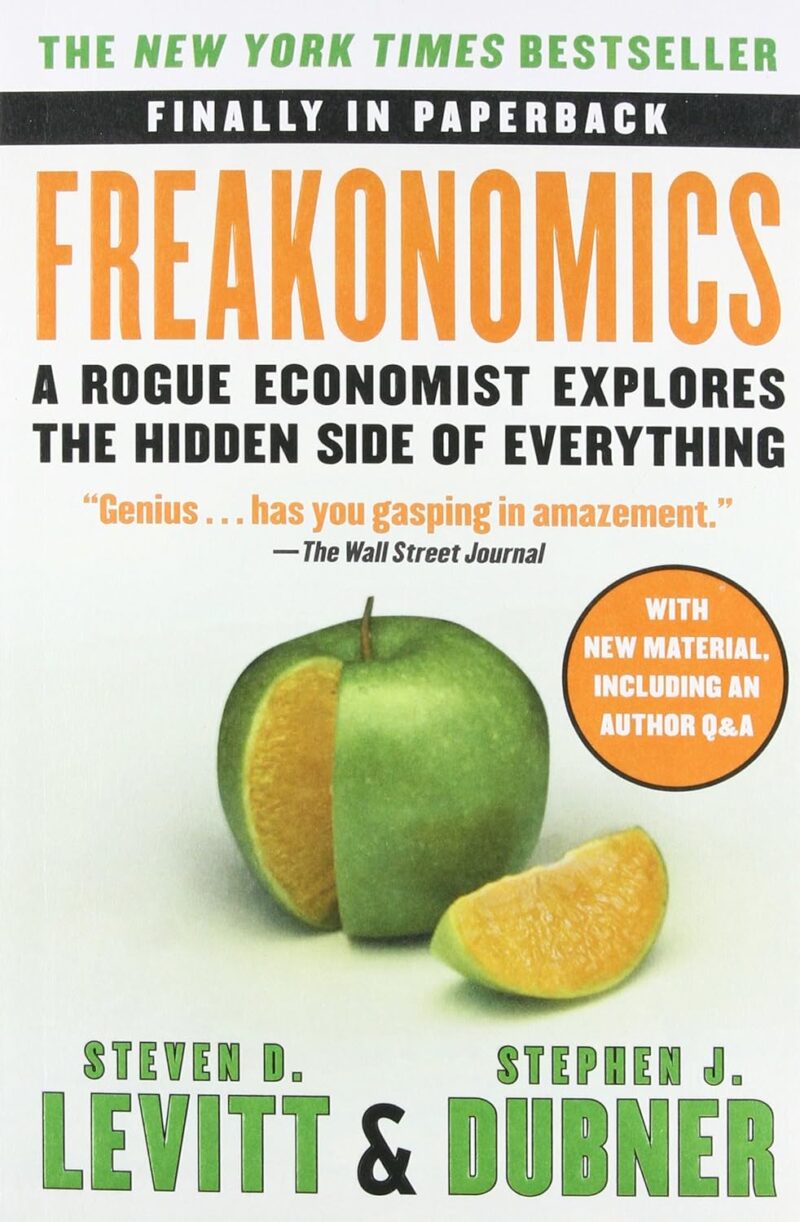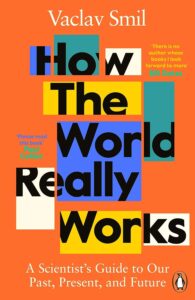A Rogue Economist Explores the Hidden Side of Everything
"Freakonomics" explores unconventional economic analyses of social issues, sparking debate, inspiring academia, and popularizing data-driven thinking in everyday life.
Subjects: Economics
“Freakonomics,” a groundbreaking work by Steven D. Levitt and Stephen J. Dubner, emerged not just as a book but as a phenomenon that reshaped how we interpret the world around us.
Published in 2005, it quickly became a bestseller, renowned for its unique approach to analyzing a wide array of socio-economic issues. Unlike traditional economic studies, “Freakonomics” delves into diverse and unconventional topics such as crime, cheating, parenting, and sports, using data-driven insights to uncover surprising and often counterintuitive conclusions about human behavior. The book’s central theme revolves around the power of incentives and how they influence actions in various contexts. Levitt and Dubner challenge established norms and conventional wisdom, offering contrarian perspectives backed by rigorous analysis. Their accessible and engaging writing style makes complex economic theories relatable and understandable to a broad audience, significantly contributing to the popularization of economics in pop culture. The influence of “Freakonomics” extends beyond the book, with sequels like “SuperFreakonomics,” a dedicated blog, and a podcast, further exploring and expanding the application of economic thought to everyday phenomena. The book’s innovative approach has firmly established it as a seminal work in demonstrating the relevance and applicability of economic thinking in understanding and interpreting the complexities of modern society.
Initial Reactions and Controversies
“Freakonomics” received a mix of acclaim and criticism upon its release. It was praised for its novel approach to economics and its engaging storytelling. However, it also faced criticism for its lack of a unifying theme and for sometimes being perceived as overly simplistic in its analysis of complex social phenomena. The book’s title itself, “Freakonomics,” was a subject of debate, embodying the book’s unconventional approach to economics.
Blogging and Ongoing Discussions
After the publication of “Freakonomics,” the authors started a blog to continue the conversation with their readers. This blog became a platform for discussing ideas from the book and for engaging in new explorations of data-driven thinking. It provided a space for the authors to respond to critiques, share further insights, and connect with an audience interested in their unique perspective on economics.
Changes in Public Perception
The release of “Freakonomics” significantly influenced public perception of economics and data analysis. The book popularized the idea of looking at the world through the lens of incentives and showed how unconventional thinking could reveal hidden truths about everyday phenomena. It brought economics into the mainstream conversation, demonstrating its relevance to a wide range of social issues.
Impact on Academia and Research
“Freakonomics” had a notable impact on academic research and methodology. It encouraged scholars to adopt more interdisciplinary approaches and to consider unconventional variables in their analyses. The book’s popularity also sparked a surge in interest in economics among students and researchers, leading to new courses and research initiatives inspired by Levitt and Dubner’s work.
Personal Reflections by the Authors
Levitt and Dubner reflected on their journey with “Freakonomics,” acknowledging the criticisms and embracing the discussions it sparked. They noted the importance of open discourse and the value of challenging established norms and perspectives. The book’s success was a testament to their belief in the power of storytelling and the appeal of exploring the hidden side of familiar subjects.
Critical Review
At its core, “Freakonomics” is not a traditional economics book. It does not deal extensively with the technicalities of economics, such as market dynamics or financial theories. Instead, Levitt and Dubner use economic principles as a tool to explore a variety of social issues and behaviors, often with startling and controversial insights. This methodological choice is both the book’s greatest strength and a point of contention among traditional economists.
The book is structured around several intriguing questions, such as the link between legalizing abortion and a drop in crime rates, or the underlying reasons behind a teacher cheating in standardized tests. These questions are explored through a combination of statistical analysis and case studies, a method that is effective in making complex ideas accessible to a general audience.
One of the most notable aspects of “Freakonomics” is its approach to causality. Levitt and Dubner challenge readers to think beyond conventional wisdom and to consider how unrelated factors might be intricately connected. For instance, the book’s examination of the drop in crime rates in the 1990s challenges the usual explanations of improved policing or economic growth, instead proposing a link to the Roe v. Wade decision in 1973. This provocative thesis is a prime example of the book’s approach: using data to uncover unexpected correlations, thereby provoking deeper thought about cause and effect.
However, this approach has been a subject of criticism. Critics argue that while the book is highly engaging, it sometimes oversimplifies complex social phenomena and overlooks the nuances of socioeconomic factors. Furthermore, the reliance on correlation can lead to controversial conclusions, raising questions about the difference between correlation and causation.
Comparatively, “Freakonomics” can be placed alongside works like Malcolm Gladwell’s “The Tipping Point” or Dan Ariely’s “Predictably Irrational.” Like “Freakonomics,” these books seek to offer insights into human behavior and social trends using principles from economics and psychology. However, what sets “Freakonomics” apart is its boldness in tackling sensitive and often overlooked subjects using economic tools.
The writing style of Levitt and Dubner is another element that deserves attention. Their journalistic approach, characterized by a clear, engaging, and sometimes humorous tone, makes complex economic theories and data analysis accessible to readers without specialized knowledge. This approachability is crucial in reaching a broad audience, thus amplifying the impact of their insights.
Conclusion
In conclusion, “Freakonomics” by Steven D. Levitt and Stephen J. Dubner offers a revolutionary perspective on economics, extending its application beyond traditional boundaries to explore the hidden aspects of everyday life. The book concludes that understanding the world requires looking beyond the obvious, focusing on the incentives and underlying mechanisms that drive human behavior. It emphasizes the importance of questioning conventional wisdom and relying on data and empirical evidence to unravel the complexities of societal issues. The authors successfully demonstrate how economic principles can provide insightful, often unexpected, interpretations of various aspects of human behavior and societal trends. The book’s conclusion is not just a summary of its contents, but a call to readers to adopt a more critical and analytical approach to understanding the world around them, challenging them to look at everyday phenomena through the lens of economic reasoning. “Freakonomics” thus leaves its readers with a new toolkit for thinking, encouraging them to explore the hidden side of everything with curiosity and skepticism.
While it has its limitations in terms of depth and academic rigor, its strength lies in its ability to provoke thought and discussion about the hidden side of everyday phenomena. It is a must-read for those interested in understanding the complexities of human behavior and societal trends through an unconventional lens.
For readers who enjoyed “Freakonomics” and are keen on exploring similar themes, I would recommend “SuperFreakonomics” by the same authors, “Outliers” by Malcolm Gladwell, or “Thinking, Fast and Slow” by Daniel Kahneman. These books, like “Freakonomics,” offer unique perspectives on human behavior and decision-making.




